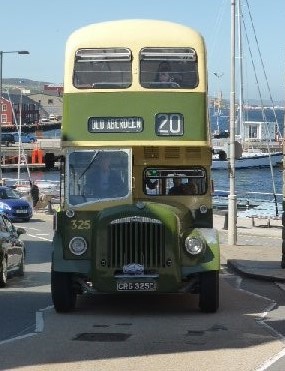The History
Aberdeen Corporation had been buying Daimlers for its double deck bus needs since 1937, their bodywork coming from various suppliers. The Alexander coachbuilding business transferred from Stirling to a new and larger plant in Camelon, Falkirk, in 1958 and thereafter Aberdeen and the other Scottish municipal bus operators often went to Alexander for their bus bodywork. Aberdeen Corporation bought its first Alexander double deck bodywork in 1959 but on AEC Regent V chassis. The same 8’0” wide H37/29R body design was used on the rebodied 1951 Daimlers (see ACT 160) and was selected for all the batches of new Daimler CVG6s bought yearly from 1961 to 1965. There were a total of 45 such vehicles, and they were thus a very typical Aberdeen Corporation bus of the 1960s. Very similar vehicles of this design combination were also operated by Dundee and Glasgow corporations.
325 was the first of the last batch ordered but had to be returned to Alexander when it sustained accident damage on its delivery run. It was then the last of the batch to be delivered but it was not only the last traditional half cab, open rear platform, double decker to enter the Aberdeen fleet, it was also the last such traditional vehicle to enter service with any of the four Scottish municipal bus fleets. It is understood that the new General Manager tried to cancel the order for this batch on taking office but the order was too far advanced.
The Daimler CVG6s of the 1960s all had ‘Daimatic’ transmission, a semi-automatic epicyclic gearbox which was the next advance in gearbox design by the Daimler company from its then revolutionary pre-select epicyclic gearbox of the early 1930s. The semi-automatic system engaged gears by electro-pneumatic valves instead of the driver having to operate a gear change pedal.
This design of vehicle required a conductor and thus fell victim to ACT’s conversion to driver only operation. All were withdrawn between 1977 and 1982, 325 coming out of ordinary service in 1980. Given its status as the last conventional double decker for the city, 325 was selected to be retained as a piece of transport history by Grampian Regional Transport. GRT’s successors kept the vehicle fit for public service and it was brought out for special events; it has been in the care of First Group Heritage Trust since 2012.

